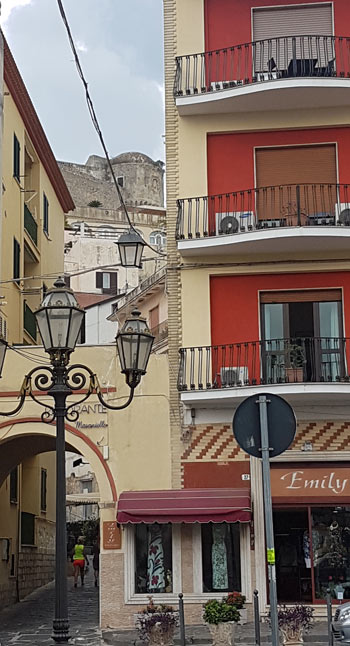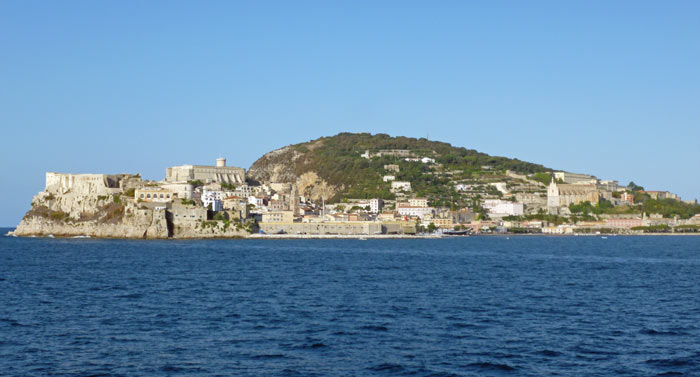A picturesque coastal town between Rome and Naples, Gaeta has three principal attractions: its setting, its history and its beaches. On a promontory near the southern limits of the Lazio region, Gaeta is only a short distance off the main coastal road and rail route between Rome and Naples, making it fairly convenient to visit and a good stop-over for a night or two on a tour of central Italy. With a couple of other interesting destinations nearby, it also offers scope for a longer holiday.
> Accommodation in Gaeta (or read on for advice on where to stay)
Historic and present-day Gaeta
Gaeta is situated on a on a bulbous, roughly triangular promontory at the end of a larger headland jutting out into the Tyrrhenian sea at the centre of the wide Gulf of Gaeta. A curving waterfront and harbour look out over a large bay, with the historic town centre clustered on the slopes behind, dominated by a large fortress. At the back of the town centre, occupying the rest of the promontory, is a hill, Monte Orlando, crowned with a lighthouse and a well-preserved Roman mausoleum. A wide and broadening neck of land joins the promontory to the rest of the mainland, and this is now built over with the streets and buildings of modern Gaeta, with a port on one side and beaches on the other.
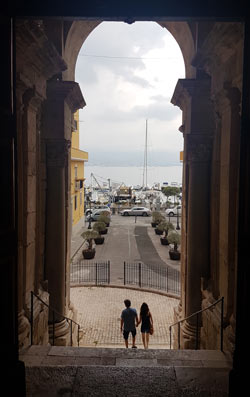
Both hill and tip of promontory look out over the sea and coastline between Rome and Naples, and this would obviously have been a very strategic location for trade and military purposes throughout history. Like much of this stretch of coast, Gaeta was a summer destination for the wealthy residents of ancient Rome. Still popular with holidaying Italians, the coastline is known as the Riviera di Ulisse (Ulysses’s Riviera) after the myths which cling to its shoreline. In the Middle Ages Gaeta’s position and its harbour helped it to the status of an independent Duchy with profitable trading connections; it even had its own currency. In the sixteenth century the town fell under the rule of Naples and was fortified as a key defensive outpost of the kingdom. In the 19th century struggles for Italian unification, Gaeta was first a refuge for the Pope and later for the Bourbon royal family of Naples and the Kingdom of the Two Sicilies. In 1860-61 the Bourbons were besieged here; the city fell in February 1861, a key event in the unification of Italy.
Nowadays there are still military and nautical presences in Gaeta, there is an active commercial and tourist port, and Gaeta is a US Naval base. The town is also a summer tourist destination, proud of its history, its traditions and its seven beaches.
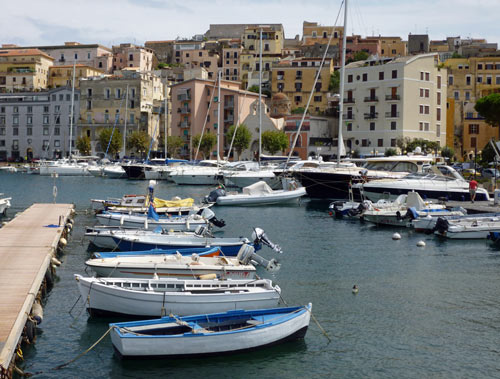
Gaeta tourist sights
Gaeta’s most interesting sights are the historic buildings of the historic centre, the Santuario della Monte Spaccata, Monte Orlando and its ruins, and depending on the time of year and your tastes, the beaches on the mainland side of town. Below I’ve described the highlights.
The best place to begin a tour of Gaeta is the town’s tourist information office, the Pro-Loco, in Piazza Traniello. This is conveniently located for those arriving by public transport, as the bus terminus is in the adjoining Piazza Caboto (named for the explorer John Cabot, said to have been born in Gaeta). Even if the office is closed, you should be able to study a map and a list of Gaeta attractions’ opening hours pinned outside. (The only exception to this as the best starting place is if you’ve already studied opening times online and feel your timing will work best with an initial visit to the Santuario; in this case, ask your bus driver and alight before the historic centre.)
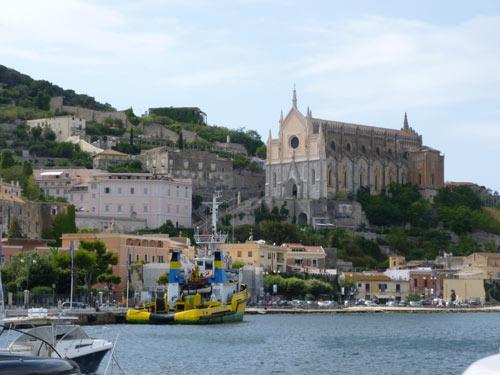
Duomo and historic centre
Gaeta’s historic centre is clustered around the headland tip dominated by the fortress and the sea. It’s interesting and picturesque to stroll around, among historic buildings, some restored and some shabby to the point of ruinous. Along the waterfront visitors can enjoy views across the coastline heading from Formia towards Naples, as well as picturesque scenes of boats in the harbour. The broad Golfo di Gaeta is very popular for sailing activities, and various nautical events take place in its waters. There are a few places to eat and drink close to the harbourside including restaurants and take-aways where you could pick up a picnic or a lunch-on-the-go. As well as seafood, freshly-caught by local fishermen, Gaeta has a convenient ‘fast food’ speciality, the tiella, a stuffed savoury dish rather like a Cornish pasty which comes with a variety of fillings. Good places to try this include the Pizzeria al Porto, a busy little take-away opposite the harbour on via Bausan.
Gaeta’s most striking feature is the fortress, the Castello Angioino-Aragonese, which stands above the centre. The present building is composed of two distinct complexes, one dating primarily to the 13th century and the other to the 15th and 16th centuries. At the time of writing the castle isn’t open to the public. Until recently it housed a military prison; now one complex is used by the Guardia di Finanza (Italy’s financial police) and the other is intended for use as a university faculty.
The town’s cathedral, the Cattedrale or Duomo, is along a lane from the tourist information point. The building’s 20th-century neo-Gothic façade is misleading; the original church was founded in 1106 and though it’s been reconstructed several times over the centuries, there is still a lot of history preserved inside. Two pairs of quaint, worn stone lions guard the door, supporting ancient columns. The two saints to whom the cathedral is dedicated, Sant’Erasmo and San Marziano stand on columns alongside (the church is also dedicated to Santa Maria Assunta). There are more ancient columns and capitals inside the building. When medieval Gaeta was built, the Roman villas on the headland provided a convenient source of building materials.
Inside the cathedral, which owes most of its appearance to an 18th-century overhaul, there are a number of fine antiquities and artworks to look out for, including a marvellous 12th-century lectern carved to depict a bearded man with a snake coiled around his body, an eagle on his head and his feet on a lion (representing the salvation of man?). Close by is the fine 13th-century Easter Candelabrum, like a miniature Trajan’s column, with carved scenes from the life of Christ, and of St Erasmus. Don’t miss a set of carved marble reliefs, also 13th-century, depicting symbolic figures such as a two-tailed mermaid, relocated here from another local church (four matching reliefs depicting animal symbols are now in the Isabella Stewart Gardner Museum in Boston). One of the side chapels contains a painting of St Catherine of Alexandria by Andrea Vaccaro. Downstairs in the cathedral’s crypt is a chapel lavishly decorated with stucco, marble and frescoes. An earlier church on this site had seven naves, and to the right of the main body of the church, you can see into the ‘seventh nave’, still retaining traces of medieval frescoes, and containing an assortment of archaeological finds. Here there is also a collection of monuments to the fallen of the Siege of Gaeta.
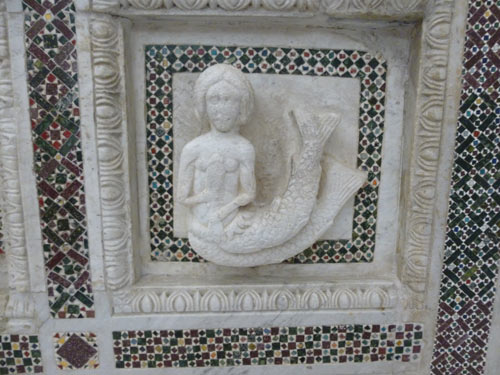
Leaving the cathedral on its seaward side, visitors pass down a stairway through the very fine bell-tower, built between the 12th and 13th centuries. In its walls are carved stones taken from a Roman mausoleum.
Other churches to visit in Gaeta include San Francesco, the town’s most conspicuous church, originally built in the 13th century but transformed by a 19th-century neo-Gothic restoration, San Giovanni Evangelista a Mare, a small and ancient treasure by the port, with a sloping floor to allow flooding high tides to drain, and the Baroque Santuario dell’Annunziata, home of the Cappella d’Oro, a richly gilded chapel where the then-exiled Pope Pius IX pondered the dogma of Papal Infallibility.
Away from the seafront, visitors with time to spare can explore Gaeta’s confusing back streets – there aren’t very many of them, but they zig-zag and climb slopes, offering occasional sea-views and quaint or shabby-picturesque corners. Other attractions to visit, subject to time, include a diocesan museum (Museo Diocesano, limited opening), a cultural museum in the Palazzo della Cultura on Via Annunziata, and a contemporary art museum (Pinacoteca di Arte Contemporanea, via De Lieto). The most interesting sights though, lie outside the historic centre, still within walking distance, and are described below.
Monte Orlando
Perhaps the most unusual feature of Gaeta is the large, ruin-dotted hill which rises behind the historic centre to form a high and largely wooded headland. Monte Orlando almost divides the historic centre from the modern suburbs and beach areas; they are connected only by the road which hugs the shore and curves around the side of the hill. Protected as a park (Parco di Monte Orlando), the hill is criss-crossed by a network of paths, with a few information signs helping the visitor to make sense of the geography. Local people and holiday-makers come here for short hiking excursions, daily exercise and leisure activities including cycling, horse-riding and running. While exploring the hillside you’ll find ruins of fortifications from different eras, including parts of a Roman villa and 18th/19th-century gun batteries and powder magazines, along with glimpses of coastal views. The most unusual and dramatic sight is at the top of the hill: a huge round Roman mausoleum, built to dominate the landscape and sea.
An excursion up the hill is an integral part of getting to know Gaeta, and is an unusual experience as well as a good, easy chance to get into natural surroundings and get some exercise away from summer crowds. It’s a good idea to plan ahead with a map, drinking water, sensible shoes with strongish soles and sun/weather protection. Think about timings and ask advice at the tourist information office if you have a busy itinerary. And check the opening times for the mausoleum and other sights if you want to go inside.
There is a zig-zag walking route which leads up the hill from the historic centre near the church of San Francesco, on via De Lieta. However for a circular excursion, I’d recommend visiting another sight, the Santuario della Montagna Spaccata, first, climbing the hill from there, and returning into the historic centre via this zig-zag lane.
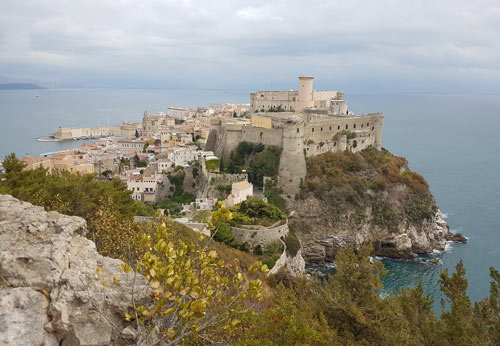
Santuario della Montagna Spaccata and Grotta del Turco
Extremely popular with Italian visitors to Gaeta, this pilgrimage destination and tourist attraction offers an assortment of unusual spectacles and legends, including tales of two miracles. The first occurred at the moment of the Crucifixion of Christ, when the mountain is said to have split in two, leaving a great fissure running vertically through the cliffs high above the sea. The religious complex built here to commemorate the event is known as the Santuario della Santissima Trinita – or more commonly, the Santuario della Montagna Spaccata (Split Mountain). Later, another legend recounts, when Turkish pirates were terrorising Italy’s coastline, they lurked around this headland. An impressive rock arch at the foot of cliffs here is called the Grotta del Turco, the Cave of the Turk and was supposedly the lair of a pirate captain. While proclaiming his disbelief of the Christian myth, he (or some other non-believer, several versions suggest a Turkish sailor) was astonished to find his hand sinking into the rocky wall of the Montagna Spaccata. He left behind a handprint in the stone, which remains as as a record of this miracle.
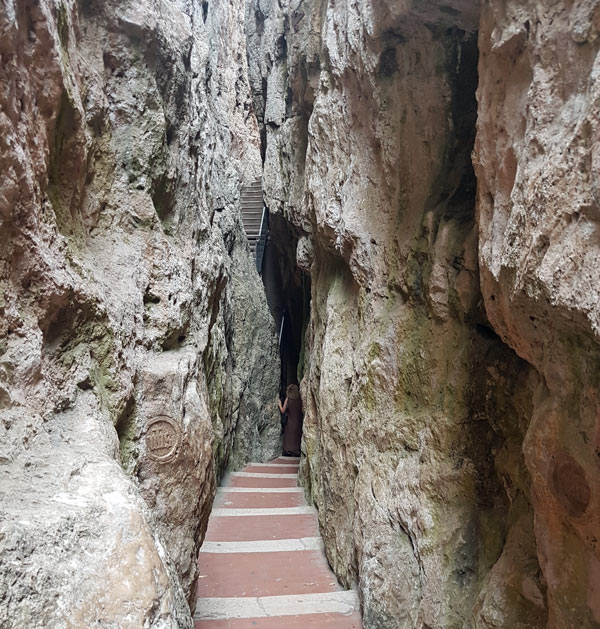
As these tales suggest, there is an unusual and bizarre combination of attractions at the Sanctuary. Modern visitors who make their way to this spot can descend a staircase to admire the the Grotta del Turco (closed lunchtimes, access via turnstile, offerings expected), visit the church, file through the Split Mountain and marvel at the miraculous handprint, making it a very varied and novel tourist attraction.
The Grotta del Turco is dramatic, but although older flights of steps descend to sea level, at the time of writing the natural phenomenon can only be admired from a viewing platform above. Visitors can get more up-close with the other big attraction here, the ‘Split Mountain’ which contains the miraculous hand print. Accessed down a lane to the right of the church, this cracked mountainside is really very impressive. Visitors can follow steps which pass through the narrow fissure in the rocks, also the route of a Via Crucis. The path leads to a small chapel perched upon a boulder which fell and became wedged in the crack in the 15th century, near a rocky alcove said to be the ‘bed’ of 16th-century saint Filippo Neri, who came here to pray. Visitors can stand upon the roof of this chapel and marvel at the remarkable surroundings. The miraculous ‘handprint of the Turk’ – La Mano del Turco – is preserved in a rock face by the path, commemorated with a Latin inscription.
There is a choice of routes to reach the Santuario from the historic centre, circling the base of Monte Orlando. The most straightforward walking route is to follow the coastal road back out of the centre, towards modern Gaeta. Part of this walk is a little dull, so non-drivers could consider taking a bus as far as the junction where the road for the Santuario, Via L.M.Planco, heads uphill, or hiring a taxi for the whole journey. There is a car park here, at the base of Monte Orlando, and additional parking close to the Santuario. From here the access road rises through woodland and past a belvedere to the Sanctuary on the cliffs. Little souvenir stalls cluster outside. There are toilets and a drinking-water tap at the sanctuary (offerings suggested).
To continue with a walk over Monte Orlando, take a signposted path leading up from the buildings on the uphill side of the complex. Look out for the ruins of Roman cisterns, part of a villa complex, by the path.
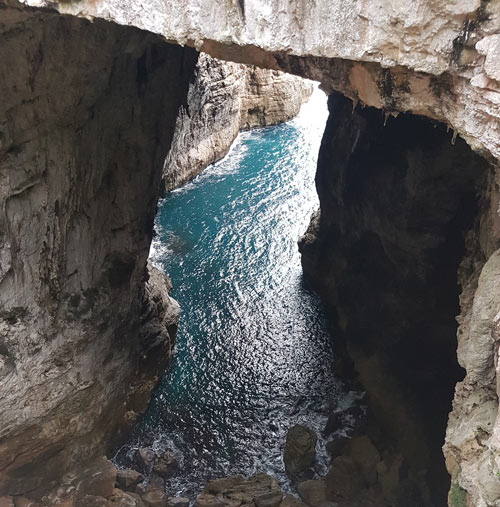
Mausoleum of Lucius Munatius Plancus on Monte Orlando
This cylindrical hilltop mausoleum (Mausoleo di Lucio Munazio Planco) was built as a monument to Lucius Munatius Plancus, who lived from approximately 90BC to 1AD. A Roman senator and consul, Lucius Munatius Plancus was an ally of Julius Caesar and later switched his allegiance from Mark Anthony to the future emperor Octavian, shifting successfully with the times. He owned a grand villa in Gaeta, and the mausoleum was probably built in its grounds. It is open to the public, but with limited and seasonal opening hours (small entrance charge).
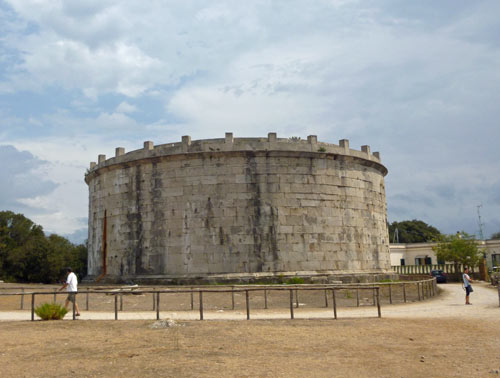
The mausoleum is signposted from most of the footpaths and access points on Monte Orlando as ‘Mausoleo L.M.Planco’. From either the historic centre or the Montagna Spaccata, the ascent is likely to take around 30-40 minutes. Starting from the Montagna Spaccata, where the track begins with gentle zig-zags in a well-laid but bumpy stone surface, allows for a varied and scenic ramble which will lead you over the hill and back down into the historic centre of Gaeta. Other paths lead off, some with signposts. It’s helpful if you have a map, or photograph one of the information sign maps, as the footpath layout is somewhat confusing. If you have time to roam and explore, there is plenty to enjoy and discover in these picturesque natural surroundings, including the military ruins dotted around the slopes, many dating from the 18th and 19th centuries. Although the hill is mostly wooded, there are moments when the view opens up to reveal the sea, or Gaeta’s beaches, and among ruined fortifications and olive trees the visitor will occasionally find wooden benches for resting and enjoying the surroundings.
The mausoleum is situated on a bare, woodland-fringed plateau at the summit of Monte Orlando. A cylindrical construction, like the more famous monuments still surviving in Rome such as Castel Sant’ Angelo and the Mausoleum of Augustus, it is decorated around the top with a frieze of carved religious and military emblems. Although the low trees around the hilltop, and the fact you can’t access the roof, make it hard to get a full impression of the mausoleum’s commanding location when you’re standing next to it, this huge construction would have dominated the neighbouring area and must have been a striking landmark when seen from ships for two thousand years. A mound would originally have topped the cylindrical building, crowned with a statue or trophy. More recently the tomb was used as a watchtower and then a telegraph station.
The grandeur of this ancient monument can be appreciated without entering, but if you visit during opening hours it is extremely interesting to tour the interior. Inside the walls, a passage runs around the circumference of the mausoleum, along the curved inner wall of opus reticulatum, characteristic Roman brickwork. Small internal rooms or cells would have been the tombs of Lucius Munatius Plancus and his family members, and now contain various sculptures and antiquities found locally. Information boards in Italian and English explain the building and its local context.
It takes around half an hour to head back into Gaeta on foot. From the mausoleum, take the little access road downhill. This leads to more abandoned fortifications, and to a large statue of the Madonna on a panoramic terrace looking over modern Gaeta and its beaches. A turn-off to the right leads to a rough lane (‘Sentiero Gaeta Medievale’) which descends in many zig-zags the steep slope into the historic centre of Gaeta, past farm buildings and the occasional animal enclosure and offering some lovely views over the headland town from the final stretches.
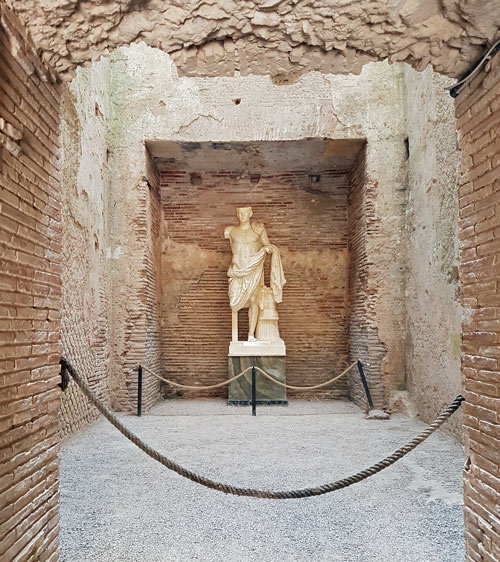
Seven beaches
Gaeta lays claim to seven sandy beaches, stretched along the coast westwards, beginning with the Spiaggia di Serapo alongside the modern part of town close to Monte Orlando. Ranging from the busy and highly-equipped – closest to town – to more natural surroundings and even a spot popular with naturists, they offer a choice of environments for sunbathing and swimming. If you’re on a short visit, the popular beaches closest to the town centre will be the most convenient. If you’re staying locally, asking your host/hotel receptionist will help you find the best beach for your tastes, the season, the wind direction etc.
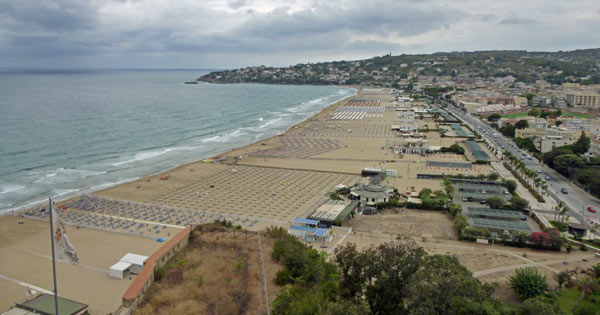
Gaeta – practicalities
It doesn’t take much time to see the historic centre of Gaeta itself, but if you want to find churches open, visit the Montagna Spaccata, climb Monte Orlando and visit the mausoleum, you’ll probably find this takes the best part of a day, planning around opening hours. Inconveniently for day-trippers, but traditionally for Italy, most churches and attractions, as well as the tourist information office, are closed for several hours in the middle of the day. Visiting in half a day might be possible if you’re very busy, very organised, and prepared to prioritise. If you’re staying long enough to utilise both morning and afternoon opening hours, you’ll probably find that strolling around, taking photographs and enjoying a leisurely meal or take-away will pleasantly fill the intervening period. If you’re visiting in the summer, you may want to spend time on Gaeta’s beaches too, so may prefer to spend two or more days based here.
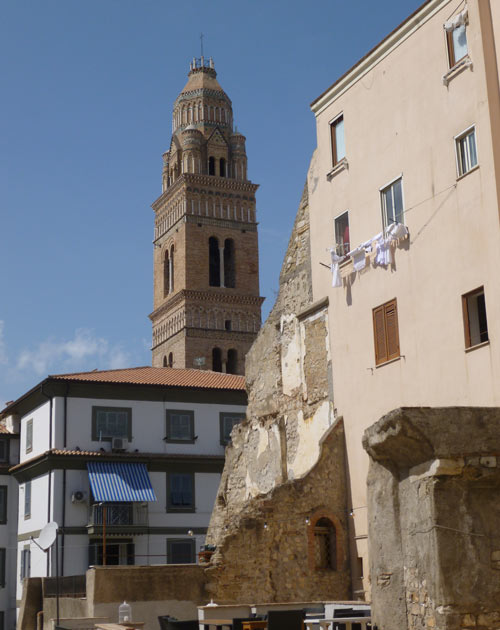
Around Gaeta
As it’s on the coast between Rome and Naples, Gaeta can be visited as part of a tour or combined with one of those cities in a multi-centre holiday. It is also possible to spend a longer holiday exploring the surrounding coastline: nearby Formia is a pleasant un-touristy town with a few sights of interest (including a huge underground Roman water cistern and a good little museum), while along the coast Sperlonga is a very pretty white-painted town on a headland, with beaches and an important Roman archaeological site and museum. These mainland towns can be combined in a varied holiday with the island of Ponza, reached by ferry from Formia, which is one of Italy’s most attractive low-key island destinations. The slow car-ferry to Ponza offers excellent views of Gaeta from the sea (faster services lack open decks).
Where to stay in Gaeta
The most atmospheric place to stay in Gaeta is definitely the Centro Storico (historic centre), out on its headland. There are a number of small B&Bs situated in the lanes of the old town, including the popular Il Viaggiatore Gaeta Medievale B&B, reached up a flight of stone steps from the cathedral, with sea-view terraces, and La Gaetana, nearby, which also has superb views of town and sea. Summer visitors and beach-lovers, however, may prefer to book accommodation in the modern part of town where the beach will be only a short stroll away. Most of the places to stay are B&Bs, with a few promising apartments for longer-stay visitors wanting to self-cater. For a more full-service experience, one local hotel option is Villa Irlanda Grand Hotel, a four-star hotel in historic buildings with two swimming pools, situated along the coast close to Formia. Along the coast in the other direction (towards Sperlonga), and perhaps of interest to travellers with a car who are looking for a special place to stay, Grand Hotel Le Rocce is romantically situated among greenery above the seashore, with its own private beach. In Gaeta itself, close to the beach and Monte Orlando, and not too far from the historic centre, the two-star Hotel Viola is a modern beach hotel with rooms with balconies.If you are on a driving tour, check the hotel/B&B’s parking arrangements before you book – not everywhere offers parking (especially in the historic centre), and sometimes it will be at additional cost.
> Gaeta hotels, B&Bs and apartments
Travel to Gaeta
The easiest way to get to Gaeta by public transport is to take the train to Formia-Gaeta station and then catch a bus or taxi to Gaeta. Located in Formia, but officially serving both towns, Formia-Gaeta station is on the main railway line heading south from Rome to Naples, so either airport makes a practical arrival point in Italy (more details on the Formia page). Buses connect Formia and Gaeta, although inconveniently not all of them seem to stop by the railway station – for those that do, look for ‘Partenze da Staz. FS’ on the timetable. Buses are operated by Cotral – quite frequent, but check timetables on the Cotral website or Gaeta Pro-Loco website – generally starting in Formia by the port at Piazzale Vespucci, then stopping in Piazza Mattei, which is about ten minutes’ walk from Formia station. Buy tickets before boarding the bus at the ticket office, news-stands or a tabaccaio. In Gaeta some bus services stop in Corso Italia in the modern town, while others circle the modern part of town before reaching their terminus in the historic centre in Piazza Traniello or the adjacent Piazza Caboto – ask the driver or check timetables. Cotral also operate other services locally, including a Mon-Sat bus to Sperlonga and a few services to Terracina.
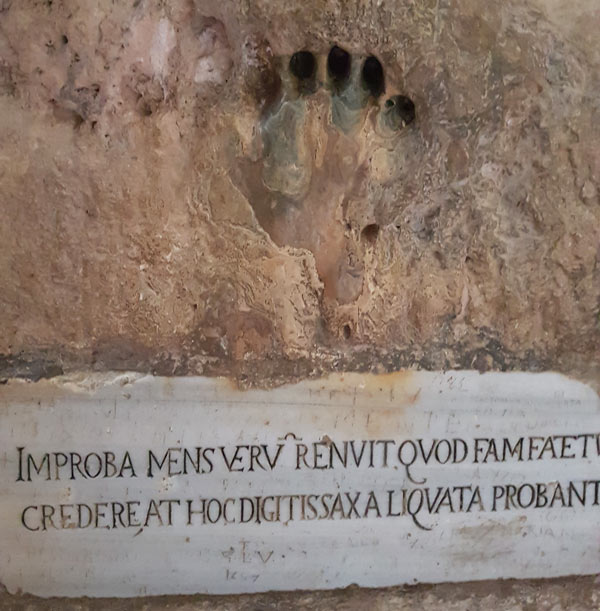
Lazio destinations
- About the Lazio region
- Anzio
- Bracciano
- Calcata
- Castel Gandolfo
- Castelli Romani
- Cerveteri
- Formia
- Frascati
- Gaeta
- Palestrina
- Pontine islands
- Ponza
- Rome
- Sperlonga
- Terracina
- Tivoli
- Ventotene
- Viterbo
Ruins and gardens
Useful external links
